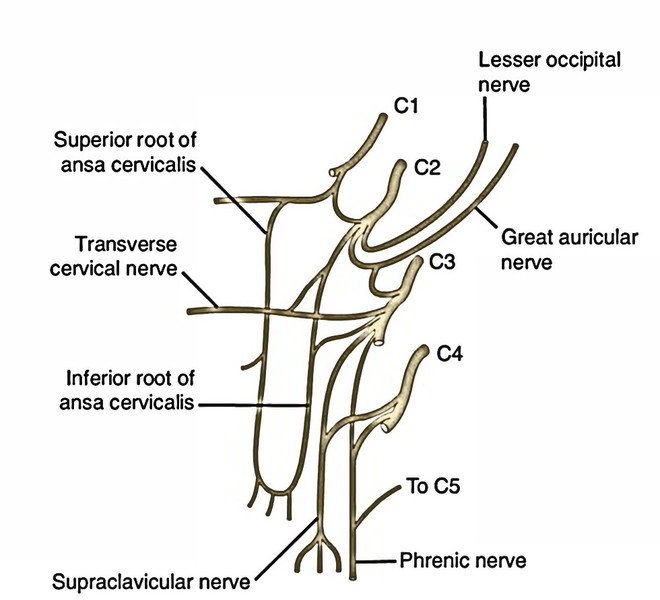Formation
The cervical plexus is also named plexus of loops because ventral ramus of C1 and branches of C2 C4 ventral rami are joined with 1 another to create 3 loops. The very first loop is directed forwards in front of the transverse process of atlas and the remaining 2 loops are directed backwards.Ventral rami of the upper 4 cervical nerves create it. The ventral rami of c2-c4 break up into upper and lower branches.
Position and Connections
The cervical plexus is located on levator scapulae and scalenus medius muscles deep to prevertebral fascia, internal jugular vein and sternocleidomastoid.
Branches
The cervical plexus supplies skin and muscles of the neck and the thoracoabdominal diaphragm. Its branches are ordered into superficial and deep groups.
Superficial (cutaneous) branches are as follows:
- Lesser occipital nerve (C2).
- Great auricular nerve (C2, C3).
- Transverse (anterior) cervical nerve (C2, C3).
- Supraclavicular nerve (C3, C4).
Deep branches are as follows:
Communication branches, viz.:
- Gray rami communicantes from superior cervical sympathetic ganglion to all the 4 roots.
- A branch of C1 joins the hypoglossal nerve.
- A branch from C2 to sternocleidomastoid and branches from C3 C4 to trapezius convey with spinal accessory nerve.
Muscular branches: These muscles are supplied by cervical plexus:
- Rectus capitis anterior (C1).
- Rectus capitis lateralis (C1, C2).
- Longus capitis (C1 C3).
- Longus colli (C2 C4).
- Strap muscles (C1 C3).
- Sternocleidomastoid (C2).
- Trapezius (C3, C4).
- Levator scapulae (C3, C4).
- Scalene muscles (C3, C4).
- Diaphragm (C3, C4).


 (56 votes, average: 4.52 out of 5)
(56 votes, average: 4.52 out of 5)